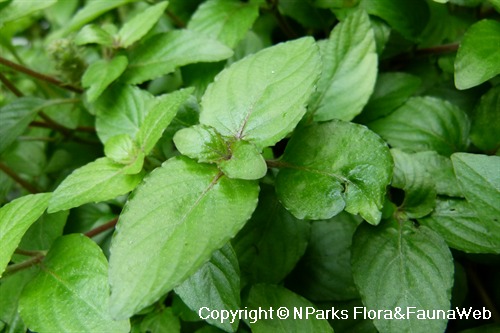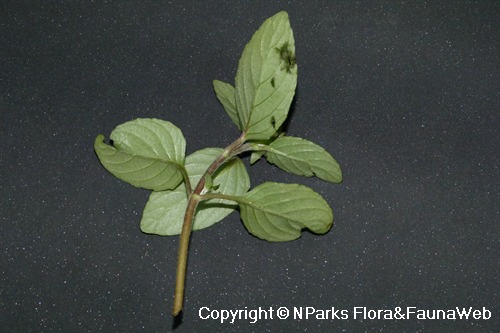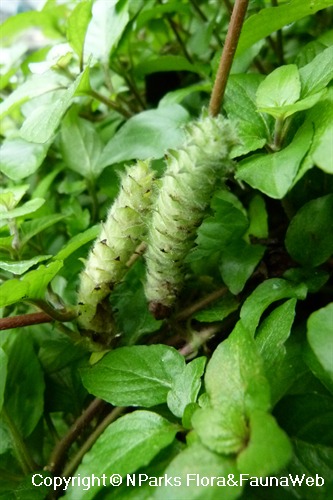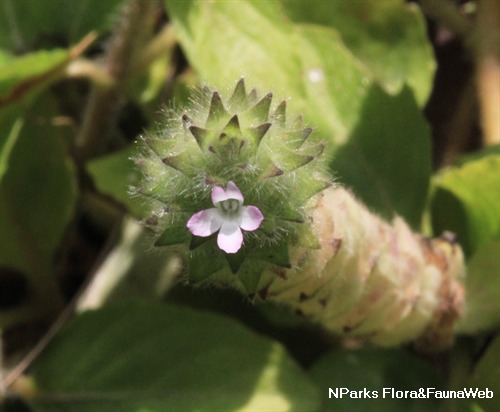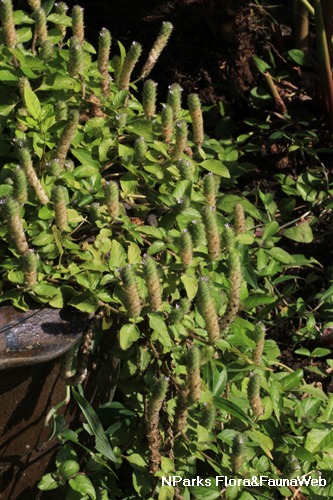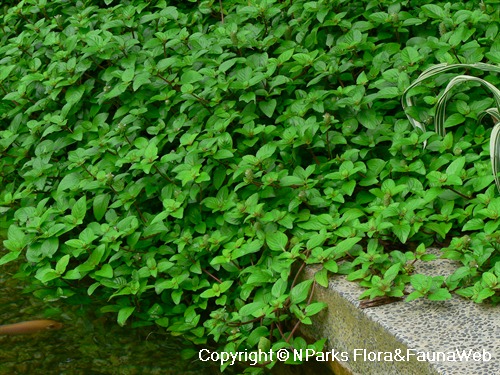
Back
Nelsonia canescens (Lam.) Spreng.
| Family Name: | Acanthaceae |
| Synonyms: | Justicia brunelloides, Justicia canescens, Nelsonia brunelloides |
| Common Name: | Blue Pussyleaf |
Name
Classifications and Characteristics
| Plant Growth Form | Creeper, Herbaceous Plant |
|---|---|
| Mode of Nutrition | Autotrophic |
| Maximum Height | 0.4 m |
Biogeography
| Native Distribution | Africa |
|---|
Description and Ethnobotany
| Others - Plant Morphology | Growth Form: Herbaceous perennial with trailing or erect growth habit. Habitat: Occurs in savanna grasslands. Found in shady locations near streams or between rocks that become submerged after heavy rainfall. Stems: Stems are thickly covered in soft, long hairs. Foliage: Opposite, sessile leaves are elliptic with entire leaf margin. They are deeply veined and densely covered in long, soft hairs. Flowers: White or bluish to purplish flowers are bilabiate with a small, bi-lobed upper lip and a large, tri-lobed lower lip. White flowers are uniformly white, while purple flowers have an upper lip streaked with dark purple lines. Flowers are arranged in spike inflorescences and occur between leaf-like bracts that are ovate and hairy. Fruits: Dry, dehiscent fruits are known as capsules. They are oblong and pointed at the tips. Landscaping: This species produces striking bluish flowers. It is not commonly used in landscaping, so it would provide a unique look. This species could be used as a groundcover in poorly drained areas, because it is tolerant of waterlogged soils. It is also shade tolerant, so it could be planted underneath a tree or large shrub. Cultivation: This species grows best in fertile, well-drained soil that is kept moist. However, it is tolerant of waterlogged soils. Propagation: Propagate by seed or stem cuttings. Etymology: The species epithet "canescens" refers to the leaves which are canescent (covered in white, thin hairs). |
|---|---|
| Associated Fauna | Host plant of Grey pansy Junonia atlites |
| Ethnobotanical Uses | Food (Herb or Spice) Others: Medicine: Leaf extracts reduced inflammation and provided pain relief in a rat model study by Owoyele et al. (2005). Whole plant extracts are rich in antioxidants which are compounds that remove disease-causing free radicals from the body (Sawadogo et al. 2006). Other: Fongod et al. (2010) found that planting this species as a cover crop in banana plantations reduced the number of weeds by 60 - 100%, repelled snails and improved crop yield. |
Fauna, Pollination and Dispersal
| Fauna Pollination Dispersal Associated Fauna | Butterfly-Attracting |
|---|
Plant Care and Propagation
| Light Preference | Full Shade |
|---|---|
| Water Preference | Moderate Water |
| Rootzone Tolerance | Waterlogged Soils (Drains Site) |
Foliar
| Mature Foliage Colour(s) | Green |
|---|---|
| Mature Foliage Texture(s) | Hairy / Hirsute |
| Foliar Type | Simple / Unifoliate |
| Foliar Arrangement Along Stem | Opposite |
| Foliar Shape(s) | Non-Palm Foliage (Elliptical) |
| Foliar Venation | Pinnate / Net |
| Foliar Margin | Entire |
| Foliar Apex - Tip | Acute |
Floral (Angiosperm)
| Flower Colour(s) | Blue, Purple, White |
|---|---|
| Flower Symmetry | Bilateral |
| Individual Flower Shape | Labiate / Lipped |
| Inflorescence Type | Spike |
| Flowering Habit | Polycarpic |
Fruit, Seed and Spore
| Fruit Classification | Simple Fruit |
|---|---|
| Fruit Type | Dehiscent Dry Fruit , Capsule |
Image Repository
Others
| Master ID | 30639 |
|---|---|
| Species ID | 4948 |
| Flora Disclaimer | The information in this website has been compiled from reliable sources, such as reference works on medicinal plants. It is not a substitute for medical advice or treatment and NParks does not purport to provide any medical advice. Readers should always consult his/her physician before using or consuming a plant for medicinal purposes. |

